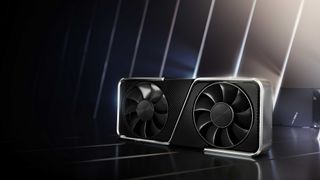Nvidia GeForce RTX 40 series: Price, specs and everything we know
Here's everything you need to know about the Nvidia RTX 40 series

Nvidia GeForce RTX 40-series graphics cards are the latest (and greatest?) Nvidia GPUs currently available.
The first batch of cards released in late 2022, with more affordable models released throughout 2023. The company now has the RTX 40 Super Series, which began dropping this year. With that, it's easier to get an RTX 40 series card that fits your budget.
Here’s everything you need to know about the Nvidia GeForce RTX 4000 series.
Nvidia GeForce RTX 40 series: Release date and price
The Nvidia GeForce RTX 4080 was unveiled on September 20 and began shipping on November 2022 from third-party manufacturers like Asus, Gigabyte, PNY and more. It launched with a $1,199 price tag, which is still its current price. For that, you'll get 9,728 CUDA cores and 16GB of onboard memory. Nvidia claims it's more powerful than the 3090 Ti at lower power, and with DLSS 3 can achieve 2x the performance as the GeForce RTX 3080 Ti.
The discontinued GeForce RTX 4080 12GB had 7,680 CUDA cores and 12GB of Micron GDDR6X memory onboard. Nvidia claimed it's faster than the RTX 3090 Ti with DLSS 3.
If you've got your sight set on a new Nvidia GPU, here are all the details you need on where to buy Nvidia GeForce RTX 4080.

Nvidia also unveiled the more powerful GeForce RTX 4090, its new top-of-the-line card. It went on sale earlier than the RTX 4080 (October 12) at a starting price of $1,599. As with the RTX 4080 16GB, Nvidia sold Founders Edition versions of the 4090 alongside configurations sold by third-party vendors like Gigabyte and MSI.
Sign up to get the BEST of Tom’s Guide direct to your inbox.
Upgrade your life with a daily dose of the biggest tech news, lifestyle hacks and our curated analysis. Be the first to know about cutting-edge gadgets and the hottest deals.
For that $1,599 price tag, you'll get a massive card with 76 billion transistors, 16,384 CUDA cores and 24GB of Micron GDDR6X memory. Nvidia claims it can consistently deliver up to 4x the performance (when using DLSS 3) of the GeForce RTX 3090 Ti using DLSS 2, as well as promising it can consistently deliver 100 frames per second when gaming at 4K. While Nvidia declined to specify which game(s) were run in 4K to achieve that performance, the CUDA core count alone is enough to impress.

The GeForce RTX 4070 Ti hit the market on January 5 with an MSRP of $799. As some predicted, this new RTX 4070 Ti GPU looks an awful lot like a rebranded version of the $899 GeForce RTX 4080 12GB GPU that Nvidia announced, then abruptly canceled late in 2022. Based on the specs, the RTX 4070 Ti seems likely that it's the same card Nvidia tried to launch as the RTX 4080 12GB last November.
The RTX 4070 was released on April 12. This GPU costs $599 compared to the $799 RTX 4070 Ti.
The RTX 4060 and RTX 4060 Ti are the most affordable Nvidia GPUs currently available — coming at $299 and $399, respectively. The former is available as of June 29 but the latter won't drop until sometime in July.
Leaker Kopite7kimi (via Tom's Hardware), reported via Twitter that internal Nvidia plans to launch what would have been an RTX 4090 Ti have been canceled. "I'm afraid there won't be RTX 4090 Ti anymore," said the generally reliable leaker. "Some low-grade AD103 and AD106 chips will be another version of RTX 4070 and 4060."
The Nvidia RTX 4070 Super, RTX 4070 Ti Super and RTX 4080 Super were all unveiled on Jan 8 during Nvidia's CES 2024 livestreamed presentation. These new cards are the Nvidia RTX 4070 Super ($599), the RTX 4070 Ti Super ($799) and the RTX 4080 Super ($999). Together they help add a new middle tier of RTX 40-series GPU between the top-tier RTX 4090 ($1,599) and the mid-grade RTX 4070 ($549).
Nvidia GeForce RTX 40 series: Specs
Per Nvidia's press release, the RTX 4090 is "the world’s fastest gaming GPU with astonishing power, acoustics and temperature characteristics." According to the company, in full ray-traced games, the RTX 4090 with DLSS 3 is up to 4 times faster compared to last generation’s RTX 3090 Ti with DLSS 2.
It's also up to 2 times faster in modern games while maintaining the same 450W power consumption. This GPU features 76 billion transistors, 16,384 CUDA cores and 24GB of high-speed Micron GDDR6X memory. It is capable of consistently delivering over 100 frames per second at 4K resolution gaming, according to NVIDIA.
| Row 0 - Cell 0 | NVIDIA CUDA Cores | Boost Clock Speed | Memory |
| GeForce RTX 4090 ($1,599) | 16,384 | 2.52 GHz | 24 GB GDDR6X |
| GeForce RTX 4080 Super ($999) | 10,240 | 2.55 GHz | 16 GB GDDR6X |
| GeForce RTX 4080 ($1,199) | 9,728 | 2.51 GHz | 16 GB GDDR6X |
| GeForce RTX 4070 Ti Super ($799) | 8,448 | 2.61 GHz | 16 GB GDDR6X |
| GeForce RTX 4070 Ti ($799) | 7,680 | 2.61 GHz | 12 GB GDDR6X |
| GeForce RTX 4070 Super ($599) | 7,168 | 2.47 GHz | 12 GB GDDR6X |
| GeForce RTX 4070 ($549) | 5,888 | 2.47 GHz | 12 GB GDDR6X |
| GeForce RTX 4060 Ti ($399) | 4,352 | 2.35 GHz | 8GB GDDR6X |
| GeForce RTX 4060 ($279) | 3,848 | 2.35 GHz | 8GB GDDR6X |
The RTX 4080 has 9,728 CUDA cores and 16GB of the aforementioned high-speed Micron GDDR6X memory. With DLSS 3, Nvidia claims the card is 2 times as fast in modern games as the GeForce RTX 3080 Ti and more powerful than the GeForce RTX 3090 Ti at lower power.
The Nvidia GeForce RTX 4070 Ti ships with 7,680 CUDA cores and 12GB of GDDR6X memory, Which puts it on the low end of the Nvidia GeForce RTX 40-series of GPUs, though according to Nvidia, it's still significantly faster than the last-generation RTX 3090 Ti when you enable DLSS 3 (unique to the 40-series GPUs).
Of course, the discontinued GeForce RTX 4080 12GB also had 7,680 CUDA cores and 12GB of Micron GDDR6X memory onboard. Hence, it's pretty clear Nvidia has listened to customer backlash and rebranded the $899 "4080 12GB" as the more reasonable $799 RTX 4070 Ti, cutting the cost by $100 in the process.
The RTX 4070 features 5,888 CUDA Cores and 12GB of GDDR6X memory. It has a TDP of 200, which is less than the 285W of the RTX 4070 Ti.

DLSS 3 is an AI-driven feature that's meant to boost performance while maintaining solid image quality and responsiveness. As Nvidia said, DLSS 3 adds Optical Multi Frame Generation to generate entirely new frames, and integrates NVIDIA Reflex low latency technology for better responsiveness. DLSS 3 is powered by the new fourth-generation Tensor Cores and Optical Flow Accelerator of the NVIDIA Ada Lovelace architecture, which powers the RTX 40 series.
The new RT cores are capable of delivering two times faster ray-triangle intersection testing. They also include an Opacity Micromap Engine, which speeds up ray tracing of alpha-test geometry by a factor of two. In addition, a Micro-Mesh Engine generates micro-meshes on the fly to generate additional geometry. According to the company, the Micro-Mesh Engine provides the benefits of increased geometric complexity without the traditional performance and storage costs of complex geometries.
Nvidia GeForce RTX 40 series: Features
All RTX 40-series family of GPUs these new Nvidia cards will support all the same features, most notably DLSS 3.
If you've not seen it in action yet, DLSS 3 is an AI-driven feature intended to boost performance in games while maintaining image quality. While previous iterations of DLSS were already pretty good performance optimizers, DLSS 3 adds Optical Multi Frame Generation technology to generate entirely new frames, and integrates NVIDIA Reflex low latency technology for better responsiveness. DLSS 3 is driven in part by the new fourth-generation Tensor Cores and Optical Flow Accelerator of the NVIDIA Ada Lovelace architecture, which powers the RTX 40-series cards.
These new RT cores are capable of delivering faster ray-triangle intersection testing than their predecessors and include fancy tech (like an Opacity Micromap Engine and a Micro-Mesh Engine) which help speed up rendering and ray tracing, so your games look better with less work on your PC's part.
While games need to fully support DLSS in order to take full advantage of all the features, many modern games do these days. I've played a few with the benefits of DLSS 3 on a modern Nvidia 40-series GPU, and I can say that the fancy frame generation and image upscaling tech really do work wonders to make your games look amazing.
Nvidia GeForce RTX 40 series: Outlook
If you’re a PC gamer, then the latest Nvidia cards are enough to get excited about. RTX cards aren't as difficult to get as the RTX 30 series, though we have seen some price gouging at certain retailers. Thankfully, prices aren't nearly as exorbitant as the previous generation.
Generally speaking, if you want a new RTX 40 series card, you should be able to find out at market value. Hopefully, this trend will continue throughout the GPUs' lifecycle.

Tony is a computing writer at Tom’s Guide covering laptops, tablets, Windows, and iOS. During his off-hours, Tony enjoys reading comic books, playing video games, reading speculative fiction novels, and spending too much time on X/Twitter. His non-nerdy pursuits involve attending Hard Rock/Heavy Metal concerts and going to NYC bars with friends and colleagues. His work has appeared in publications such as Laptop Mag, PC Mag, and various independent gaming sites.
